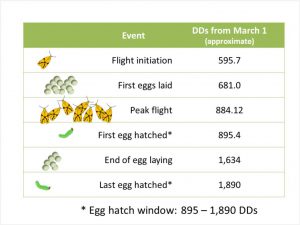Asparagus growers should consider scouting their fields during the summer months for foliar disease development. Important pathogens that growers need to scout for on a regular basis include Purple spot, Cercospora, and Rust. [Read more…]
Archives for July 2017
WPS “Protect Yourself from Pesticides” Poster Now Available
WPS “Protect Yourself from Pesticides” Poster Now Available
WPS “Protect Yourself from Pesticides” Poster Now Available
Veg IPM Update: Week Ending 7/05/17
Sweet Corn
European corn borer (ECB) catches continue to be extremely low, and no map will appear in this edition. Feeding in NJ sweet corn plantings is highly variable, but with second and third plantings now reaching the silk stage, we find that later plantings have much less damage. Check 5 plants each in 10 random locations for a 50 plant sample. Look for “shot-hole” injury, and consider treating when the number of infested plants in a 50 plant sample exceeds 12%. As infested plants proceed to the pre-tassel stage, live larvae and damage may be found in the emerging tassels. Once plants hit full tassel, ECB larvae will move downward on the stalk and re-enter the plant near the area where ears are forming. This can result in direct injury to the ear. Growers should consider an insecticide application at the full tassel stage to target ECB larvae as they migrate downward. This application can eliminate larvae that have escaped any earlier insecticide applications. [Read more…]
Sparganothis Fruitworm Degree-Day Update: as of July 05, 2017
Based on our degree-day (DD) model for Sparganothis fruitworm, first eggs hatched at about 900 DD (see chart). As of July 05, Sparganothis has accumulated 1,358 DD (using March 1 as biofix) or 1,318 DD (using April 1 as biofix). This indicates that most eggs should have hatched by now and fruit is susceptible to infestation. Most beds are out of bloom (early varieties) or should be coming out of bloom. Thus, if trap counts have been high, then a post-bloom application might be necessary. Growers should consider treatment in the next few days (as soon as bees are removed) to prevent damage to berries. Your best post-bloom options are Diazinon, Altacor, or Delegate.

Sparganothis fruitworm degree-day benchmarks
